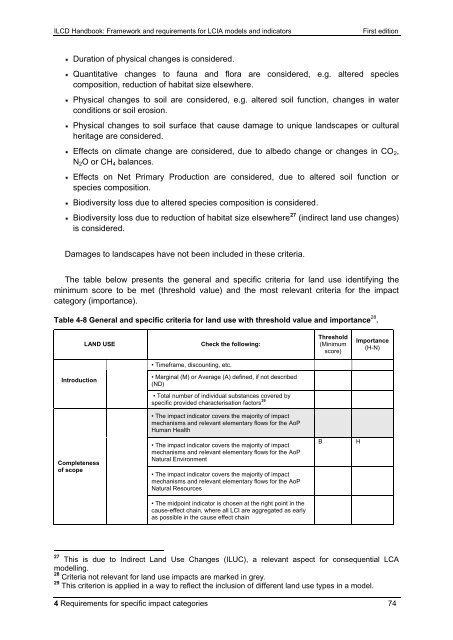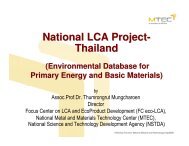ILCD Handbook: Framework and requirements for LCIA models and ...
ILCD Handbook: Framework and requirements for LCIA models and ...
ILCD Handbook: Framework and requirements for LCIA models and ...
Create successful ePaper yourself
Turn your PDF publications into a flip-book with our unique Google optimized e-Paper software.
<strong>ILCD</strong> <strong>H<strong>and</strong>book</strong>: <strong>Framework</strong> <strong>and</strong> <strong>requirements</strong> <strong>for</strong> <strong>LCIA</strong> <strong>models</strong> <strong>and</strong> indicators First edition<br />
Duration of physical changes is considered.<br />
Quantitative changes to fauna <strong>and</strong> flora are considered, e.g. altered species<br />
composition, reduction of habitat size elsewhere.<br />
Physical changes to soil are considered, e.g. altered soil function, changes in water<br />
conditions or soil erosion.<br />
Physical changes to soil surface that cause damage to unique l<strong>and</strong>scapes or cultural<br />
heritage are considered.<br />
Effects on climate change are considered, due to albedo change or changes in CO2,<br />
N2O or CH4 balances.<br />
Effects on Net Primary Production are considered, due to altered soil function or<br />
species composition.<br />
Biodiversity loss due to altered species composition is considered.<br />
Biodiversity loss due to reduction of habitat size elsewhere 27 (indirect l<strong>and</strong> use changes)<br />
is considered.<br />
Damages to l<strong>and</strong>scapes have not been included in these criteria.<br />
The table below presents the general <strong>and</strong> specific criteria <strong>for</strong> l<strong>and</strong> use identifying the<br />
minimum score to be met (threshold value) <strong>and</strong> the most relevant criteria <strong>for</strong> the impact<br />
category (importance).<br />
Table 4-8 General <strong>and</strong> specific criteria <strong>for</strong> l<strong>and</strong> use with threshold value <strong>and</strong> importance 28 .<br />
Introduction<br />
Completeness<br />
of scope<br />
LAND USE Check the following:<br />
• Timeframe, discounting, etc.<br />
• Marginal (M) or Average (A) defined, if not described<br />
(ND)<br />
• Total number of individual substances covered by<br />
specific provided characterisation factors 29<br />
• The impact indicator covers the majority of impact<br />
mechanisms <strong>and</strong> relevant elementary flows <strong>for</strong> the AoP<br />
Human Health<br />
• The impact indicator covers the majority of impact<br />
mechanisms <strong>and</strong> relevant elementary flows <strong>for</strong> the AoP<br />
Natural Environment<br />
• The impact indicator covers the majority of impact<br />
mechanisms <strong>and</strong> relevant elementary flows <strong>for</strong> the AoP<br />
Natural Resources<br />
• The midpoint indicator is chosen at the right point in the<br />
cause-effect chain, where all LCI are aggregated as early<br />
as possible in the cause effect chain<br />
Threshold<br />
(Minimum<br />
score)<br />
B H<br />
Importance<br />
(H-N)<br />
27 This is due to Indirect L<strong>and</strong> Use Changes (ILUC), a relevant aspect <strong>for</strong> consequential LCA<br />
modelling.<br />
28 Criteria not relevant <strong>for</strong> l<strong>and</strong> use impacts are marked in grey.<br />
29 This criterion is applied in a way to reflect the inclusion of different l<strong>and</strong> use types in a model.<br />
4 Requirements <strong>for</strong> specific impact categories 74



